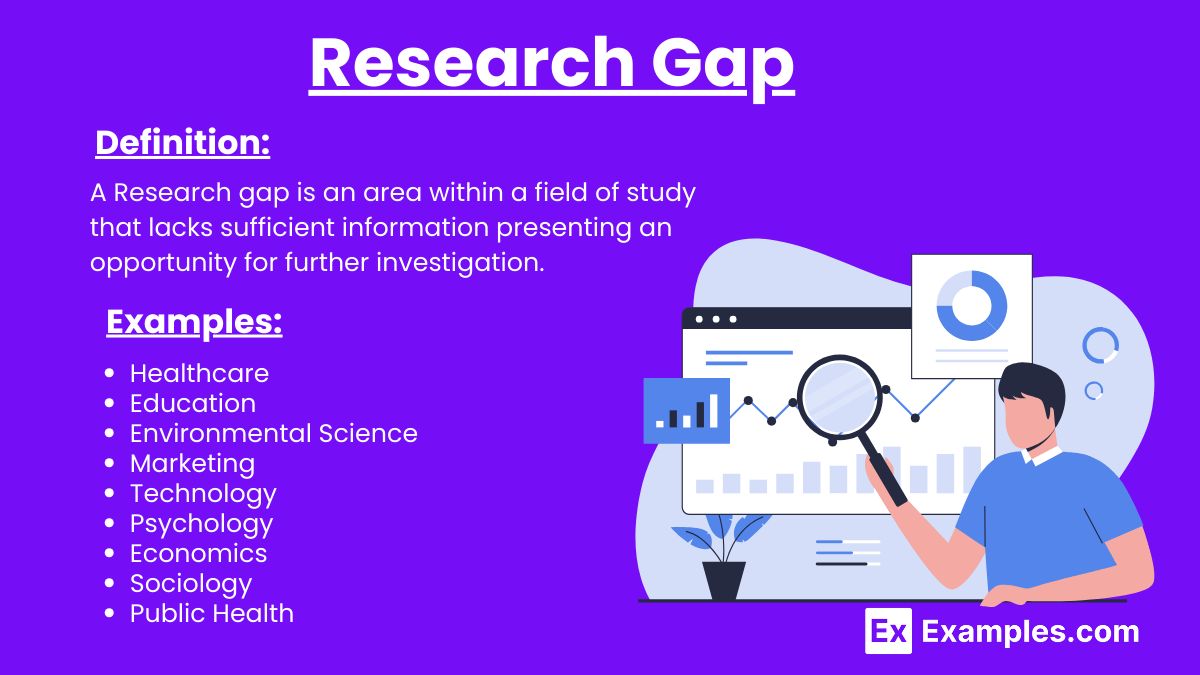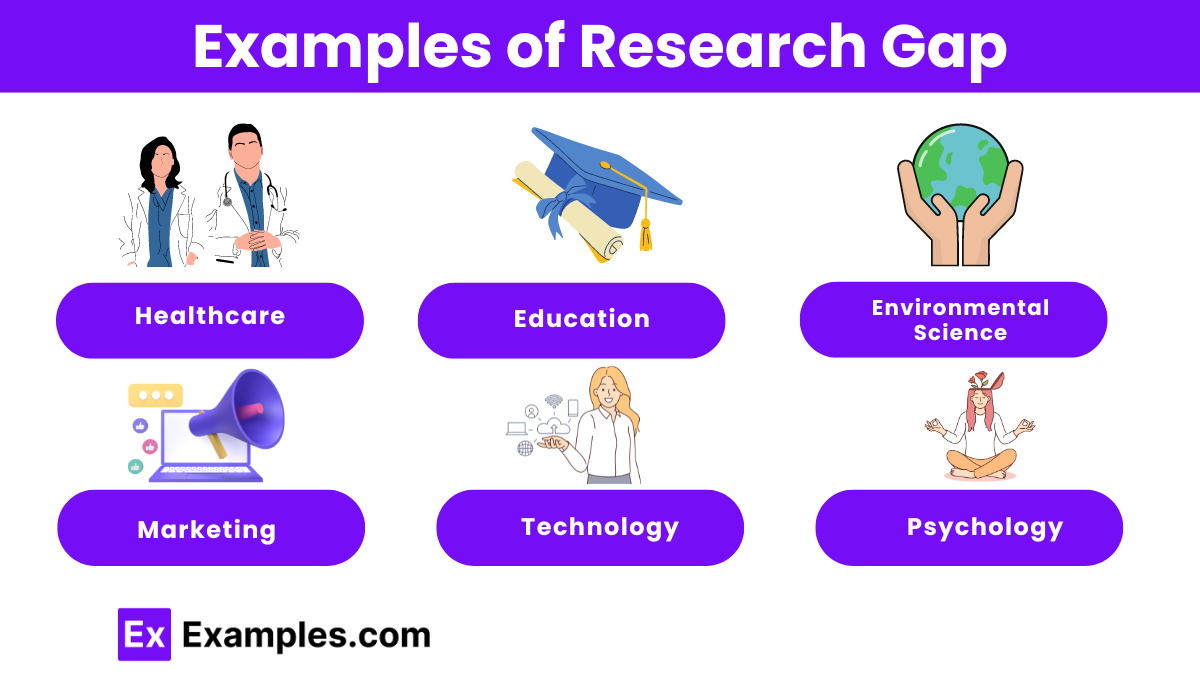

Research Gap
Ai generator.

A research gap is an area within a field that lacks sufficient information or understanding, highlighting opportunities for further investigation. Identified through literature review, it guides researchers to explore new questions and develop innovative theories. Addressing these gaps advances knowledge and solves real-world problems. In areas like Marketing Gap Analysis , identifying research gaps leads to more effective strategies and improved market performance.
What is a Research Gap?
A research gap is an area within a field of study that lacks sufficient information or understanding, presenting an opportunity for further investigation. It is identified through a thorough review of existing literature and highlights areas where more research is needed. Recognizing these gaps is essential for advancing knowledge, guiding researchers to explore new questions, develop innovative theories, and improve methodologies.
Examples of Research Gap

- Healthcare : Limited studies on the long-term effects of telemedicine on patient outcomes, especially in rural areas.
- Education : Insufficient research on the impact of virtual reality in improving student engagement and learning outcomes in primary education.
- Environmental Science : Lack of comprehensive data on the effects of microplastics on marine ecosystems.
- Marketing : Few studies exploring the influence of social media influencers on consumer behavior in emerging markets.
- Technology : Sparse research on the ethical implications of artificial intelligence in workplace decision-making processes.
- Psychology : Limited understanding of the mental health impacts of prolonged social media use among teenagers.
- Economics : Insufficient analysis of the effects of cryptocurrency adoption on traditional banking systems.
- Sociology : Lack of in-depth studies on the long-term effects of remote work on family dynamics and work-life balance.
- Public Health : Few studies examining the effectiveness of community-based interventions in reducing obesity rates among children.
- Renewable Energy : Limited research on the integration of renewable energy sources into existing power grids and their economic impacts.
Different Types of Research Gaps
Research gaps are areas where knowledge is lacking or where existing research could be expanded. Identifying and addressing these gaps is crucial for advancing knowledge in any field. Here are the different types of research gaps:
1. Evidence Gap
Definition : An evidence gap occurs when there is a lack of empirical data to support conclusions or theories. This gap signifies areas where more research is needed to provide solid evidence for or against a hypothesis.
Example : Limited studies on the long-term effects of a new medication.
2. Knowledge Gap
Definition : A knowledge gap refers to a lack of understanding or awareness about a specific topic. This gap often highlights areas where research has not yet been conducted or where findings are inconsistent.
Example : Insufficient knowledge about the impact of social media on mental health among teenagers.
3. Practical-Knowledge Gap
Definition : This gap arises when there is a disconnect between theoretical research and practical application. It points to areas where findings from research have not been implemented in real-world settings or where practical challenges are not addressed by existing research.
Example : Theoretical models for disaster management that are not tested in actual disaster scenarios.
4. Methodological Gap
Definition : A methodological gap is identified when current research methods are inadequate to address certain research questions. This gap indicates the need for new or improved research methods.
Example : The need for longitudinal studies to better understand the progression of chronic diseases.
5. Policy Gap
Definition : A policy gap occurs when research does not inform policy or when there is a lack of research supporting existing policies. This gap often highlights the need for research that can influence or evaluate policy decisions.
Example : Lack of research on the effectiveness of policies aimed at reducing carbon emissions.
6. Population Gap
Definition : This gap is present when certain populations or demographic groups are underrepresented in research. It calls attention to the need for more inclusive research that considers diverse populations.
Example : Underrepresentation of elderly populations in clinical trials for new medications.
7. Theory Gap
Definition : A theory gap is found when there is a lack of theoretical framework to explain certain phenomena. This gap suggests the need for developing or refining theories to better understand specific issues.
Example : Incomplete theoretical explanations for the rise of extremism in modern societies.
8. Contextual Gap
Definition : A contextual gap exists when research does not take into account the context in which a phenomenon occurs. This gap highlights the need for studies that consider environmental, cultural, or situational factors.
Example : Studies on education methods that do not consider cultural differences in learning styles.
9. Perspective Gap
Definition : This gap arises when certain perspectives or viewpoints are missing from the research. It emphasizes the need for more diverse viewpoints to provide a comprehensive understanding of a topic.
Example : Limited perspectives from minority groups in research on workplace diversity.
10. Data Gap
Definition : A data gap is identified when there is a lack of available data or when existing data is insufficient to support research conclusions. This gap indicates the need for more extensive data collection and analysis.
Example : Insufficient data on climate change impacts in specific geographic regions.
How to write Research Gap
Identifying and articulating a research gap is a crucial step in academic research. It highlights the need for your study and sets the stage for your research question and objectives. Here’s a step-by-step guide on how to write a research gap:
1. Literature Review
Conduct a thorough literature review to understand the current state of research in your field. Look for recent studies, key theories, and significant findings. Take note of any inconsistencies, unanswered questions, or areas that have not been explored.
2. Identify the Gap
After reviewing the literature, pinpoint the specific areas where research is lacking. This could be due to insufficient evidence, outdated studies, contradictory findings, or unaddressed issues.
3. Justify the Gap
Explain why this gap is important. Discuss the implications of not addressing this gap and how filling it could advance knowledge in your field or solve a practical problem.
4. Formulate Your Research Question
Based on the identified gap, formulate a clear and focused research question. This question should aim to address the gap and guide your study.
5. Contextualize the Gap
Place your research gap within the broader context of your field. Explain how your study will contribute to the existing body of knowledge and why it is timely and relevant.
6. Use Clear and Concise Language
When writing about the research gap, be clear and concise. Avoid jargon and ensure that your explanation is understandable to readers outside your immediate field.
How to Identify Research Gap?
Identifying a research gap is essential for developing a relevant and impactful research question. Here are the steps to effectively identify a research gap:
1. Conduct a Comprehensive Literature Review
Start by thoroughly reviewing existing literature in your area of interest. Use academic databases, journals, books, and conference papers to gather information. Focus on:
- Recent studies and their findings
- Key theories and models
- Methodologies used
- Areas of consensus and disagreement
2. Analyze the Literature Critically
While reviewing the literature, critically evaluate the studies. Look for:
- Inconsistencies : Contradictory findings or conclusions
- Outdated Information : Studies that need updating due to new data or advancements
- Methodological Flaws : Weaknesses or limitations in research methods
- Unanswered Questions : Questions that previous studies have raised but not answered
3. Identify Trends and Patterns
Identify trends and patterns in the existing research. Consider:
- Common themes and topics
- Frequently used methodologies
- Populations and settings studied
- Gaps in data and analysis
4. Look for Understudied Areas
Identify topics or subtopics that have not been extensively researched. Pay attention to:
- Emerging fields or new technologies
- Neglected populations or regions
- Interdisciplinary research opportunities
5. Consult Reviews and Meta-Analyses
Review articles and meta-analyses can provide a summary of the current state of research and highlight areas where further research is needed. They often suggest future research directions and gaps.
6. Analyze Research Agendas and Funding Opportunities
Research agendas and funding calls from academic institutions, government agencies, and private organizations can highlight priority areas and identify gaps that need addressing.
7. Discuss with Experts and Peers
Engage in discussions with experts, mentors, and peers in your field. They can provide insights into current research trends and gaps that you might have overlooked.
8. Examine Conference Proceedings
Conference proceedings often contain the latest research and can indicate emerging trends and gaps. Attend conferences and review the abstracts and presentations.
9. Evaluate the Practical Relevance
Consider the practical implications of existing research. Identify areas where research findings have not been applied or where practical challenges remain unaddressed.
10. Formulate Research Questions
Based on the identified gaps, develop specific research questions. These questions should address the gaps and guide your research towards filling them.
Research Gap Uses
1. advancing knowledge.
Filling a research gap helps in advancing the overall knowledge within a field. It allows researchers to build upon existing studies and contribute new insights, theories, or methods.
2. Innovative Solutions
Addressing a research gap can lead to the development of innovative solutions to existing problems. Researchers can explore new approaches, technologies, or applications that have not been previously considered.
3. Funding and Support
Identifying a significant research gap can attract funding and support from academic institutions, government bodies, and private organizations. Funders are often interested in supporting projects that promise new discoveries and advancements.
4. Publishing Opportunities
Research that addresses a gap is often seen as valuable and original, increasing the chances of publication in reputable academic journals. This can enhance the researcher’s profile and credibility within the academic community.
5. Educational Development
For educators and students, identifying research gaps can guide the development of curricula and educational programs. It ensures that teaching materials are up-to-date and relevant to current academic and industry trends.
FAQ’s
Why is identifying a research gap important.
Identifying a research gap helps focus efforts on unexplored areas, advancing knowledge and contributing to the field.
How can I identify a research gap?
Review current literature, analyze findings, and note areas lacking comprehensive studies or conflicting results.
What are the types of research gaps?
Types include evidence gaps, knowledge gaps, practical gaps, theoretical gaps, and methodological gaps.
What is an evidence gap?
An evidence gap exists when there is a lack of empirical data supporting a particular hypothesis or theory.
How does a theoretical gap differ from a practical gap?
A theoretical gap involves missing or underdeveloped concepts, while a practical gap involves real-world issues needing solutions.
What is a methodological gap?
A methodological gap arises when certain methods have not been applied to study a specific problem.
How can conflicting results indicate a research gap?
Conflicting results suggest inconsistencies in findings, pointing to areas needing further investigation.
What is the role of a literature review in identifying research gaps?
A literature review helps identify gaps by summarizing existing studies and highlighting areas needing further research.

Can technology advancements create research gaps?
Yes, new technologies can reveal gaps by enabling studies that were previously impossible or overlooked.
What is the impact of research gaps on funding opportunities?
Identifying significant gaps can attract funding by demonstrating the need for research in unexplored areas.
Text prompt
- Instructive
- Professional
10 Examples of Public speaking
20 Examples of Gas lighting
- Link to facebook
- Link to linkedin
- Link to twitter
- Link to youtube
- Writing Tips
How to Identify a Research Gap

5-minute read
- 10th January 2024
If you’ve been tasked with producing a thesis or dissertation, one of your first steps will be identifying a research gap. Although finding a research gap may sound daunting, don’t fret! In this post, we will define a research gap, discuss its importance, and offer a step-by-step guide that will provide you with the essential know-how to complete this critical step and move on to the rest of your research project.
What Is a Research Gap?
Simply put, a research gap is an area that hasn’t been explored in the existing literature. This could be an unexplored population, an untested method, or a condition that hasn’t been investigated yet.
Why Is Identifying a Research Gap Important?
Identifying a research gap is a foundational step in the research process. It ensures that your research is significant and has the ability to advance knowledge within a specific area. It also helps you align your work with the current needs and challenges of your field. Identifying a research gap has many potential benefits.
1. Avoid Redundancy in Your Research
Understanding the existing literature helps researchers avoid duplication. This means you can steer clear of topics that have already been extensively studied. This ensures your work is novel and contributes something new to the field.
2. Guide the Research Design
Identifying a research gap helps shape your research design and questions. You can tailor your studies to specifically address the identified gap. This ensures that your work directly contributes to filling the void in knowledge.
3. Practical Applications
Research that addresses a gap is more likely to have practical applications and contributions. Whether in academia, industry, or policymaking, research that fills a gap in knowledge is often more applicable and can inform decision-making and practices in real-world contexts.
4. Field Advancements
Addressing a research gap can lead to advancements in the field . It may result in the development of new theories, methodologies, or technologies that push the boundaries of current understanding.
5. Strategic Research Planning
Identifying a research gap is crucial for strategic planning . It helps researchers and institutions prioritize areas that need attention so they can allocate resources effectively. This ensures that efforts are directed toward the most critical gaps in knowledge.
6. Academic and Professional Recognition
Researchers who successfully address significant research gaps often receive peer recognition within their academic and professional communities. This recognition can lead to opportunities for collaboration, funding, and career advancement.
How Do I Identify a Research Gap?
1. clearly define your research topic .
Begin by clearly defining your research topic. A well-scoped topic serves as the foundation for your studies. Make sure it’s not too broad or too narrow; striking the right balance will make it easier to identify gaps in existing literature.
Find this useful?
Subscribe to our newsletter and get writing tips from our editors straight to your inbox.
2. Conduct a Thorough Literature Review
A comprehensive literature review is a vital step in any research. Dive deep into the existing research related to your topic. Look for patterns, recurring themes, and consensus among scholars. Pay attention to areas where conflicting opinions or gaps in understanding emerge.
3. Evaluate Existing Studies
Critically evaluate the studies you encounter during your literature review. Assess the paradigms , methodologies, findings, and limitations of each. Note any discrepancies, unanswered questions, or areas where further investigation is warranted. These are potential indicators of research gaps.
4. Identify Unexplored Perspectives
Consider the perspectives presented in the existing literature. Are there alternative viewpoints or marginalized voices that haven’t been adequately explored? Identifying and incorporating diverse perspectives can often lead to uncharted territory and help you pinpoint a unique research gap.
Additional Tips
Stay up to date with emerging trends.
The field of research is dynamic, with new developments and emerging trends constantly shaping the landscape. Stay up to date with the latest publications, conferences, and discussions in your field and make sure to regularly check relevant academic search engines . Often, identifying a research gap involves being at the forefront of current debates and discussions.
Seek Guidance From Experts
Don’t hesitate to reach out to experts in your field for guidance. Attend conferences, workshops, or seminars where you can interact with seasoned researchers. Their insights and experience can provide valuable perspectives on potential research gaps that you may have overlooked. You can also seek advice from your academic advisor .
Use Research Tools and Analytics
Leverage tech tools to analyze patterns and trends in the existing literature. Tools like citation analysis, keyword mapping, and data visualization can help you identify gaps and areas with limited exploration.
Identifying a research gap is a skill that evolves with experience and dedication. By defining your research topic, meticulously navigating the existing literature, critically evaluating studies, and recognizing unexplored perspectives, you’ll be on your way to identifying a research gap that will serve as the foundation for your paper, thesis, or dissertation topic .
If you need any help with proofreading your research paper , we can help with our research paper editing services . You can even try a sample of our services for free . Good luck with all your research!
Share this article:
Post A New Comment
Got content that needs a quick turnaround? Let us polish your work. Explore our editorial business services.
Free email newsletter template.
Promoting a brand means sharing valuable insights to connect more deeply with your audience, and...
6-minute read
How to Write a Nonprofit Grant Proposal
If you’re seeking funding to support your charitable endeavors as a nonprofit organization, you’ll need...
9-minute read
How to Use Infographics to Boost Your Presentation
Is your content getting noticed? Capturing and maintaining an audience’s attention is a challenge when...
8-minute read
Why Interactive PDFs Are Better for Engagement
Are you looking to enhance engagement and captivate your audience through your professional documents? Interactive...
7-minute read
Seven Key Strategies for Voice Search Optimization
Voice search optimization is rapidly shaping the digital landscape, requiring content professionals to adapt their...
4-minute read
Five Creative Ways to Showcase Your Digital Portfolio
Are you a creative freelancer looking to make a lasting impression on potential clients or...

Make sure your writing is the best it can be with our expert English proofreading and editing.

Identifying Research Gaps to Pursue Innovative Research
This article is an excerpt from a lecture given by my Ph.D. guide, a researcher in public health. She advised us on how to identify research gaps to pursue innovative research in our fields.
What is a Research Gap?
Today we are talking about the research gap: what is it, how to identify it, and how to make use of it so that you can pursue innovative research. Now, how many of you have ever felt you had discovered a new and exciting research question , only to find that it had already been written about? I have experienced this more times than I can count. Graduate studies come with pressure to add new knowledge to the field. We can contribute to the progress and knowledge of humanity. To do this, we need to first learn to identify research gaps in the existing literature.
A research gap is, simply, a topic or area for which missing or insufficient information limits the ability to reach a conclusion for a question. It should not be confused with a research question, however. For example, if we ask the research question of what the healthiest diet for humans is, we would find many studies and possible answers to this question. On the other hand, if we were to ask the research question of what are the effects of antidepressants on pregnant women, we would not find much-existing data. This is a research gap. When we identify a research gap, we identify a direction for potentially new and exciting research.

How to Identify Research Gap?
Considering the volume of existing research, identifying research gaps can seem overwhelming or even impossible. I don’t have time to read every paper published on public health. Similarly, you guys don’t have time to read every paper. So how can you identify a research gap?
There are different techniques in various disciplines, but we can reduce most of them down to a few steps, which are:
- Identify your key motivating issue/question
- Identify key terms associated with this issue
- Review the literature, searching for these key terms and identifying relevant publications
- Review the literature cited by the key publications which you located in the above step
- Identify issues not addressed by the literature relating to your critical motivating issue
It is the last step which we all find the most challenging. It can be difficult to figure out what an article is not saying. I like to keep a list of notes of biased or inconsistent information. You could also track what authors write as “directions for future research,” which often can point us towards the existing gaps.
Different Types of Research Gaps
Identifying research gaps is an essential step in conducting research, as it helps researchers to refine their research questions and to focus their research efforts on areas where there is a need for more knowledge or understanding.
1. Knowledge gaps
These are gaps in knowledge or understanding of a subject, where more research is needed to fill the gaps. For example, there may be a lack of understanding of the mechanisms behind a particular disease or how a specific technology works.
2. Conceptual gaps
These are gaps in the conceptual framework or theoretical understanding of a subject. For example, there may be a need for more research to understand the relationship between two concepts or to refine a theoretical framework.
3. Methodological gaps
These are gaps in the methods used to study a particular subject. For example, there may be a need for more research to develop new research methods or to refine existing methods to address specific research questions.
4. Data gaps
These are gaps in the data available on a particular subject. For example, there may be a need for more research to collect data on a specific population or to develop new measures to collect data on a particular construct.
5. Practical gaps
These are gaps in the application of research findings to practical situations. For example, there may be a need for more research to understand how to implement evidence-based practices in real-world settings or to identify barriers to implementing such practices.
Examples of Research Gap
Limited understanding of the underlying mechanisms of a disease:.
Despite significant research on a particular disease, there may be a lack of understanding of the underlying mechanisms of the disease. For example, although much research has been done on Alzheimer’s disease, the exact mechanisms that lead to the disease are not yet fully understood.
Inconsistencies in the findings of previous research:
When previous research on a particular topic has inconsistent findings, there may be a need for further research to clarify or resolve these inconsistencies. For example, previous research on the effectiveness of a particular treatment for a medical condition may have produced inconsistent findings, indicating a need for further research to determine the true effectiveness of the treatment.
Limited research on emerging technologies:
As new technologies emerge, there may be limited research on their applications, benefits, and potential drawbacks. For example, with the increasing use of artificial intelligence in various industries, there is a need for further research on the ethical, legal, and social implications of AI.
How to Deal with Literature Gap?
Once you have identified the literature gaps, it is critical to prioritize. You may find many questions which remain to be answered in the literature. Often one question must be answered before the next can be addressed. In prioritizing the gaps, you have identified, you should consider your funding agency or stakeholders, the needs of the field, and the relevance of your questions to what is currently being studied. Also, consider your own resources and ability to conduct the research you’re considering. Once you have done this, you can narrow your search down to an appropriate question.
Tools to Help Your Search
There are thousands of new articles published every day, and staying up to date on the literature can be overwhelming. You should take advantage of the technology that is available. Some services include PubCrawler , Feedly , Google Scholar , and PubMed updates. Stay up to date on social media forums where scholars share new discoveries, such as Twitter. Reference managers such as Mendeley can help you keep your references well-organized. I personally have had success using Google Scholar and PubMed to stay current on new developments and track which gaps remain in my personal areas of interest.
The most important thing I want to impress upon you today is that you will struggle to choose a research topic that is innovative and exciting if you don’t know the existing literature well. This is why identifying research gaps starts with an extensive and thorough literature review . But give yourself some boundaries. You don’t need to read every paper that has ever been written on a topic. You may find yourself thinking you’re on the right track and then suddenly coming across a paper that you had intended to write! It happens to everyone- it happens to me quite often. Don’t give up- keep reading and you’ll find what you’re looking for.
Class dismissed!
How do you identify research gaps? Share your thoughts in the comments section below.
Frequently Asked Questions
A research gap can be identified by looking for a topic or area with missing or insufficient information that limits the ability to reach a conclusion for a question.
Identifying a research gap is important as it provides a direction for potentially new research or helps bridge the gap in existing literature.
Gap in research is a topic or area with missing or insufficient information. A research gap limits the ability to reach a conclusion for a question.
Thank u for your suggestion.
Very useful tips specially for a beginner
Thank you. This is helpful. I find that I’m overwhelmed with literatures. As I read on a particular topic, and in a particular direction I find that other conflicting issues, topic a and ideas keep popping up, making me more confused.
I am very grateful for your advice. It’s just on point.
The clearest, exhaustive, and brief explanation I have ever read.
Thanks for sharing
Thank you very much.The work is brief and understandable
Thank you it is very informative
Thanks for sharing this educative article
Thank you for such informative explanation.
Great job smart guy! Really outdid yourself!
Nice one! I thank you for this as it is just what I was looking for!😃🤟
Thank you so much for this. Much appreciated
Thank you so much.
Thankyou for ur briefing…its so helpful
Thank you so much .I’ved learn a lot from this.❤️
Very exciting and useful piece for researchers.
Your are awesome, it’s a great article.
Thanks alot. It is very useful
The kind of article I have been looking for. Thanks for this
Rate this article Cancel Reply
Your email address will not be published.

Enago Academy's Most Popular Articles

- Reporting Research
Choosing the Right Analytical Approach: Thematic analysis vs. content analysis for data interpretation
In research, choosing the right approach to understand data is crucial for deriving meaningful insights.…

Comparing Cross Sectional and Longitudinal Studies: 5 steps for choosing the right approach
The process of choosing the right research design can put ourselves at the crossroads of…

- Career Corner
Unlocking the Power of Networking in Academic Conferences
Embarking on your first academic conference experience? Fear not, we got you covered! Academic conferences…

Research Recommendations – Guiding policy-makers for evidence-based decision making
Research recommendations play a crucial role in guiding scholars and researchers toward fruitful avenues of…

- AI in Academia
Disclosing the Use of Generative AI: Best practices for authors in manuscript preparation
The rapid proliferation of generative and other AI-based tools in research writing has ignited an…
Avoiding the AI Trap: Pitfalls of relying on ChatGPT for PhD applications
10 Ways to Help Students Restore Focus on Learning
Switching Your Major As a Researcher: Things to Consider Before Making the Decision

Sign-up to read more
Subscribe for free to get unrestricted access to all our resources on research writing and academic publishing including:
- 2000+ blog articles
- 50+ Webinars
- 10+ Expert podcasts
- 50+ Infographics
- 10+ Checklists
- Research Guides
We hate spam too. We promise to protect your privacy and never spam you.
- Industry News
- Publishing Research
- Promoting Research
- Diversity and Inclusion
- Infographics
- Expert Video Library
- Other Resources
- Enago Learn
- Upcoming & On-Demand Webinars
- Open Access Week 2024
- Peer Review Week 2024
- Publication Integrity Week 2024
- Conference Videos
- Enago Report
- Journal Finder
- Enago Plagiarism & AI Grammar Check
- Editing Services
- Publication Support Services
- Research Impact
- Translation Services
- Publication solutions
- AI-Based Solutions
- Thought Leadership
- Call for Articles
- Call for Speakers
- Author Training
- Edit Profile
I am looking for Editing/ Proofreading services for my manuscript Tentative date of next journal submission:

Which among these would you prefer the most for improving research integrity?

IMAGES
VIDEO